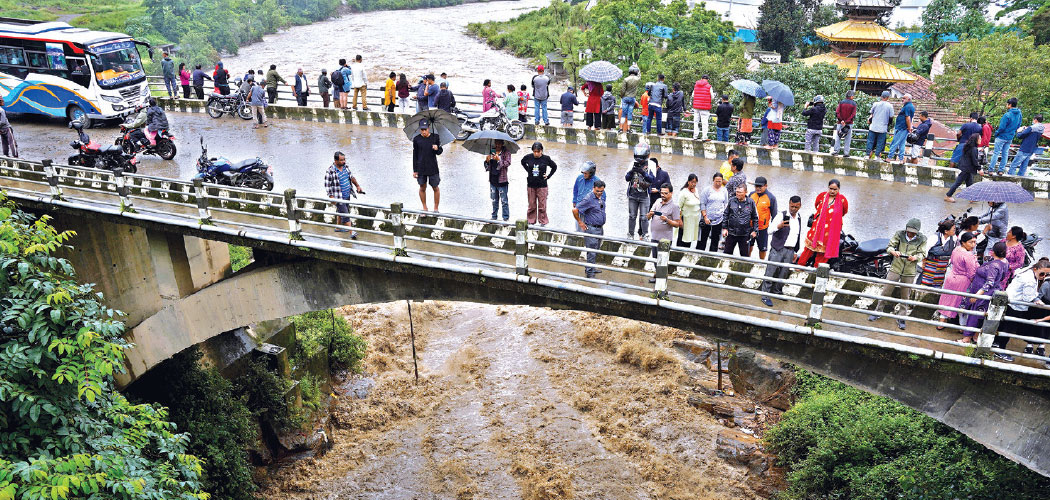
SATV Kathmandu, July 3: Is the government actually trying to break the Chobhar gorge? Social media postings suggest the government is breaking the natural barrier, and locals have strongly opposed this.
When the people have been confused with contradicting media reports and postings in social sites, Ward No. 6 Office of Kirtipur Municipality held a public hearing on Tuesday regarding the issue.
Public concern and debate have surged on social media over the Chobhar gorge following a decision by the Risk Reduction and Management Executive Committee, chaired by Home Minister Ramesh Lekhak to remove debris accumulated in the gorge.
Top Bahadur Baniya, an engineer with the High Powered Committee for Integrated Development of the Bagmati Civilization (HPCIDBC), clarified that the government was not planning to widen the Chobhar gorge. Rather, the decision was to remove five large stones stuck in the gorge without using explosives only if they were dislodged by landslides from either side. According to the HPCIDBC report, these stones obstruct the flow of the Bagmati River during the rainy season.
At the hearing, locals voiced concerns that natural and archaeological structures could be damaged under the pretext of cleaning the gorge. They insisted that such structures must remain untouched, emphasising that the gorge is a vital natural outlet for the Kathmandu Valley.
“This is not just a gorge; it is part of our identity and culture,” said one local of Ward No 25. “We will not allow anyone to touch it or destroy it.”
Baniya explained that due to limited capacity, HPCIDBC handed over the task of removing the debris to the National Disaster Risk Reduction and Management Authority (NDRRMA), which then passed the responsibility to the Nepali Army under the leadership of the Ministry of Urban Development.
According to the report, around two metres of debris has accumulated 20 metress from the gorge, along with five large boulders stuck at the centre. The government has decided to collaborate with the Nepali Army for the removal process.
The HPCIDBC actually lacks the budget to work specifically in the Chobhar area. Last year, Rs. 20 million was allocated for cleaning certain parts of the Bagmati and Bishnumati rivers, but the work could not proceed due to technical issues. However, debris-clearing efforts have been ongoing in other locations: 71,000 cubic metres of debris needs to be removed from the Bagmati River opposite the Kirtipur Gate, 17,000 cubic metres from Gokarneshwor, and 15,000 from Teku, where the Bagmati and Bishnumati rivers meet.
Initially, Ward No. 18 of Lalitpur Metropolitan City requested debris removal from both sides of the gorge to mitigate flood damage. Later, Ward No. 6 of Kirtipur Municipality made a similar request, he informed.
At the public hearing, Khirman Singh Basnet, Chairperson of Ward No. 6, tried to assure the public that the five large stones would not be removed if they are found to be naturally embedded.
Kirtipur Mayor Krishnaman Dangol strongly committed to protecting the gorge: “A single stone will not be removed. It doesn’t matter who recommends cleaning it—no one can touch a stone.”
Rajendra Kumar KC, Member of the House of Representatives from Kathmandu-10, reaffirmed his commitment to the public, declaring “I take full responsibility for safeguarding the gorge. I will not allow anyone to lay a hand on it.”
Water heritage expert Padam Sundar Joshi argued that the government has failed to address the actual cause of flooding in Kathmandu, which, he says, is not due to the Chobhar gorge. “Removing debris from the gorge will not solve the problem. This decision is immature and appears to have hidden motives,” he warned.
Another water resources expert, Sunil Shrestha, emphasised that the Bagmati River has flowed naturally for hundreds of years and should not be disturbed. He added that many flood-prone areas were originally floodplains reserved for agriculture, not urban development. “If land mafias build housing in such areas, it is natural that floodwaters will enter those homes. The river is not to blame, the blame lies on them for settling near it.”
Experts also highlighted reasons why the natural structure of the Chobhar gorge must remain untouched. The gorge is a vital natural outlet for the Bagmati River, formed over thousands of years. Removing stones could lead to flooding, disrupt water balance, affect underground aquifers and cause geological and environmental damage.
Chobhar is also steeped in mythology. According to legend, the god Manjushree cut through the valley to drain a lake, forming the gorge. The area is home to religious sites and caves, including the Adinath Lokeshwar Temple. It is also a biodiversity hotspot, reportedly home to more than 100 species of birds, along with unique flora and fauna. Experts warn that damaging the area could lead to the extinction of these species.



















